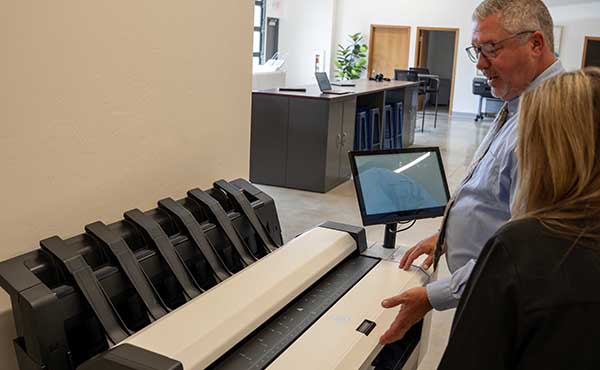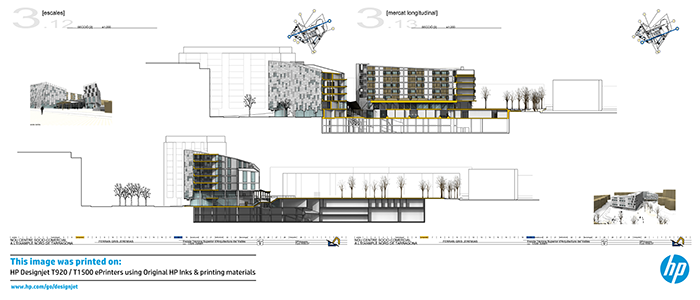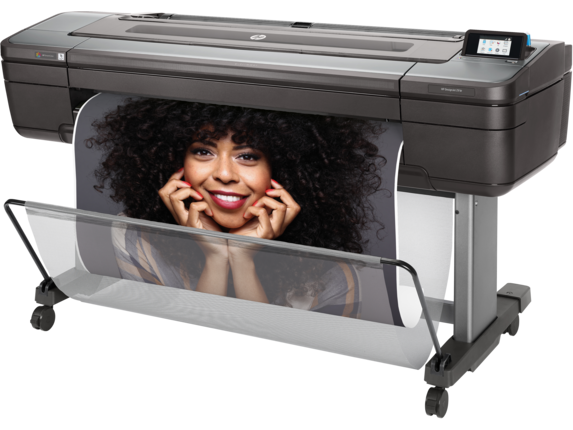
If your work involves oversized drawings, large-scale visuals, or detailed technical documents, a wide format printer—or plotter—can be a game-changer. But how do you know if it’s the right investment for your office, classroom, or job site? And what should you look for when comparing options?
This guide breaks down what wide format printing is, who it’s for, and the key factors that determine the best fit.
What Is Wide Format Printing?
Wide format printers—often called plotters—are built to handle documents larger than standard letter (8.5x11) or legal sizes (8.5x14). These devices can print on rolls of paper or specialty media ranging anywhere from 18 inches to 60 inches wide.
They’re built for precision, quality, and scale—whether that means CAD drawings with exacting line accuracy, eye-catching retail signage, or high-volume plans for a construction project.
Who’s a Fit for Wide Format—and Why?
Wide format printing is used across a wide range of industries. Here are a few examples:
- Architecture, Engineering, and Construction (AEC):
From blueprints to site plans and CAD drawings, professionals in this space need fast, accurate output—especially when details matter and deadlines are tight. Rugged printers are also essential for construction trailers or job sites. - Education:
Schools and districts use wide format printers to create colorful classroom visuals, event banners, and communication posters that get noticed. Wide format saves time and money by bringing these projects in-house. - Signage and Graphics:
Whether it’s window graphics, point-of-sale signage, trade show displays, or large-scale posters, wide format helps design and print professionals deliver eye-catching, high-impact visuals. - Government & Municipalities:
Wide format systems support mapping, zoning plans, and public notices where legibility and size matter.

Why Rhyme Partners with HP and KIP
At Rhyme, we partner with manufacturers we trust to deliver performance, reliability, and long-term value. That’s why our wide format portfolio features HP and KIP.
HP DesignJet Wide Format Printers
Designed for professionals in many different industries including but not limited to AEC, Graphic Information System (GIS), and design environments HP’s wide format lineup is all about:
- Simplicity: Easy to use, especially for teams working in hybrid or multi-location environments.
- Security: Built-in HP Wolf Security helps protect devices, data, and documents from cyber threats.
- Sustainability: With programs like ocean-bound plastic recycling and HP Planet Partners for free cartridge returns, HP is making printing more environmentally responsible.
- Media Flexibility: Supports photo paper, vinyl, fabric, and more for creative applications.

KIP Wide Format Printers
If you're in a high-volume, document-heavy environment, KIP offers:
- High-speed output that keeps projects on schedule.
- Consistent quality and sharp detail for large, technical print jobs.
- Durability built for rugged, continuous use in busy offices or job sites.
- Outdoor ready for any weather. Toner-based prints are water-resistant and well-suited for environments where documents need to withstand handling or weather.
Key Factors to Consider
Still not sure if wide format printing makes sense for your team? Ask yourself:
- How much are you printing each month?
If you’re printing under 10,000 sq. ft. per month, an inkjet model may be more efficient and affordable. Printing more than that? A toner-based system like KIP might be the better long-term fit. - What kind of materials are you producing?
Need vibrant color and rich graphics for posters or presentations? Inkjet is likely your go-to. For line accuracy and technical drawings, toner systems offer speed and sharpness. - What’s your overall budget?
Inkjet typically has a lower upfront cost. Toner systems may have a higher investment but offer lower operating costs if you’re printing high volumes. - How important is print quality?
Are you aiming for crisp technical detail, bold visuals, or both? The answer will help determine the right technology. - Where will the printer be used?
In a quiet office or a rugged job site? Compact and quiet might be best for schools or design studios, while tougher environments call for durable, high-speed systems.
The ROI of Wide Format Printing
One of the biggest benefits of wide format is eliminating the cost and delay of outsourcing. With in-house printing, you control timelines, quality, and costs—often paying off the device more quickly than expected. Wide format also reduces waste by letting you print exactly what you need, when you need it.
So... Is Wide Format Right for You?
If your work involves large-scale documents, visual-heavy output, or client-facing materials, a wide format printer could be a smart addition From compact, versatile HP DesignJets to durable, production-ready KIP systems, Rhyme can help you find the right match for your industry, team, and budget.
Explore Rhyme's Wide Format Solutions. Contact a Rhyme Client Manager to Get Started.